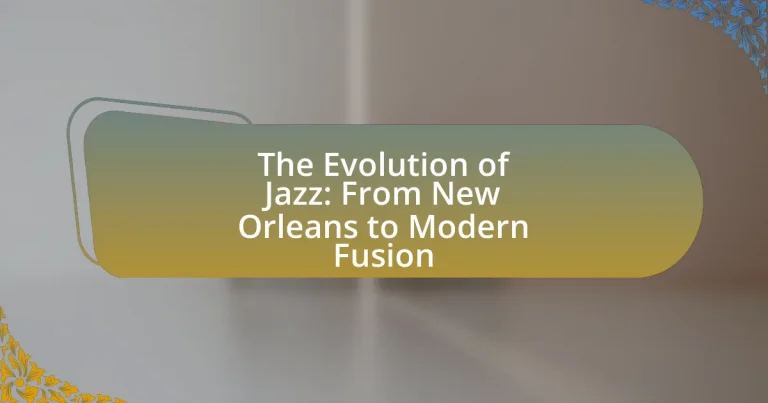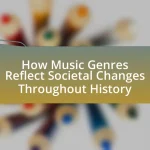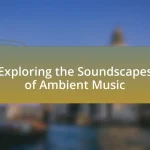The article examines the evolution of jazz, tracing its origins from New Orleans in the early 20th century to its modern fusion styles. It highlights the genre’s foundational elements, including the blending of African American musical traditions, blues, and ragtime, and discusses key figures such as Louis Armstrong and Duke Ellington who shaped its early sound. The article outlines major jazz styles that emerged over time, including swing, bebop, and cool jazz, and explores the cultural influences that contributed to its development. Additionally, it addresses the impact of jazz on social movements, its integration with other genres, and the role of technology and digital platforms in shaping its future.
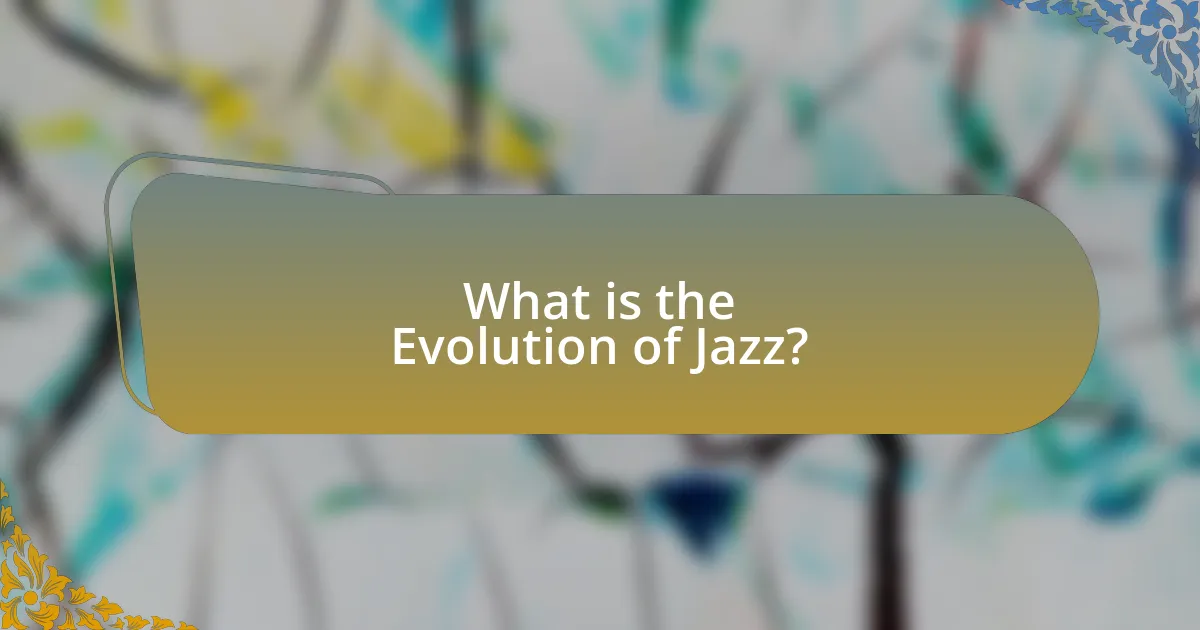
What is the Evolution of Jazz?
The evolution of jazz is a dynamic progression that began in the early 20th century in New Orleans, characterized by the blending of African American musical traditions, blues, and ragtime. This genre initially emerged in the 1910s, with key figures like Louis Armstrong and Duke Ellington shaping its early sound through improvisation and unique rhythms.
As jazz spread to cities like Chicago and New York, it underwent significant transformations, leading to the development of styles such as swing in the 1930s and bebop in the 1940s, which introduced complex harmonies and faster tempos. The 1950s saw the rise of cool jazz and hard bop, further diversifying the genre.
By the late 20th century, jazz had incorporated elements from various genres, including rock and funk, resulting in modern fusion styles. This ongoing evolution reflects jazz’s adaptability and its ability to integrate new influences while maintaining its core improvisational essence.
How did Jazz originate in New Orleans?
Jazz originated in New Orleans through a blend of African, European, and Caribbean musical traditions. The city’s unique cultural melting pot, characterized by its diverse population and vibrant social scene, facilitated the fusion of various musical styles, including blues, ragtime, and brass band music. This convergence was particularly evident in the late 19th and early 20th centuries, as musicians began to experiment with improvisation and syncopation, key elements that define jazz. The establishment of venues like Storyville, a red-light district, provided a platform for musicians to perform and innovate, further solidifying New Orleans as the birthplace of jazz.
What cultural influences shaped early Jazz music?
Early Jazz music was shaped primarily by African American musical traditions, European musical influences, and the cultural melting pot of New Orleans. African rhythms, blues, and spirituals provided the foundational elements of Jazz, while European harmonies and instruments contributed structure and form. The diverse cultural landscape of New Orleans, with its mix of African, French, Spanish, and Caribbean influences, fostered an environment where these musical styles could blend and evolve. This synthesis is evidenced by the use of improvisation, syncopation, and call-and-response patterns, which are hallmarks of early Jazz and reflect its rich cultural heritage.
Who were the key figures in the birth of Jazz?
The key figures in the birth of Jazz include Louis Armstrong, Duke Ellington, and Jelly Roll Morton. Louis Armstrong, known for his virtuosic trumpet playing and unique vocal style, significantly shaped the genre in the 1920s, bringing improvisation to the forefront. Duke Ellington, a prominent bandleader and composer, contributed to the sophistication of jazz through his innovative arrangements and orchestration. Jelly Roll Morton, a pioneering pianist and composer, is credited with blending various musical styles, including blues and ragtime, which laid the groundwork for early jazz. These artists played crucial roles in establishing jazz as a distinct musical form in the early 20th century.
What are the major styles of Jazz that emerged over time?
The major styles of jazz that emerged over time include New Orleans Jazz, Swing, Bebop, Cool Jazz, Hard Bop, Modal Jazz, and Free Jazz. New Orleans Jazz, originating in the early 20th century, is characterized by collective improvisation and a blend of African and European musical elements. Swing, which gained popularity in the 1930s, emphasized a strong rhythm and was often performed by big bands. Bebop emerged in the 1940s, focusing on complex melodies and harmonies, shifting jazz from dance music to an art form. Cool Jazz, developing in the late 1940s and 1950s, introduced a more relaxed tempo and intricate arrangements. Hard Bop, a response to Cool Jazz in the 1950s, incorporated elements of rhythm and blues. Modal Jazz, popularized by artists like Miles Davis in the late 1950s, emphasized scales rather than chord progressions. Free Jazz, emerging in the 1960s, broke traditional structures, allowing for complete improvisation. Each style reflects the cultural and musical evolution of jazz throughout its history.
How did Dixieland Jazz differ from Swing Jazz?
Dixieland Jazz primarily differs from Swing Jazz in its ensemble structure and improvisational style. Dixieland Jazz, originating in New Orleans in the early 20th century, typically features a front line of instruments such as cornet, clarinet, and trombone, with collective improvisation being a hallmark of its performance. In contrast, Swing Jazz, which emerged in the 1930s, emphasizes a larger ensemble, often including sections of brass and reeds, and focuses on arranged compositions with a more defined rhythm and soloist improvisation. This shift towards structured arrangements in Swing Jazz reflects the influence of big band orchestration, which became popular during that era.
What role did Bebop play in the evolution of Jazz?
Bebop played a crucial role in the evolution of jazz by shifting the genre from dance-oriented big band music to a more complex, improvisational form. This transformation occurred in the 1940s, characterized by faster tempos, intricate melodies, and advanced harmonies, which distinguished bebop from its predecessors. Key figures such as Charlie Parker and Dizzy Gillespie pioneered this style, emphasizing individual expression and technical virtuosity. Bebop’s influence is evident in its lasting impact on subsequent jazz styles, including cool jazz and hard bop, solidifying its position as a foundational movement in the history of jazz.
Why is the evolution of Jazz significant in music history?
The evolution of Jazz is significant in music history because it represents a transformative blend of African American musical traditions, European influences, and improvisational techniques that reshaped the landscape of modern music. Originating in the early 20th century in New Orleans, Jazz introduced innovative elements such as syncopation, swing rhythms, and call-and-response patterns, which have influenced countless genres, including rock, pop, and hip-hop. The genre’s development through various styles, such as bebop and fusion, showcases its adaptability and cultural impact, making it a cornerstone of American music and a vital expression of social change and artistic freedom.
How has Jazz influenced other music genres?
Jazz has significantly influenced various music genres, including rock, hip-hop, and R&B. The improvisational elements and complex rhythms of jazz have been integrated into rock music, with artists like Chuck Berry and The Beatles incorporating jazz-inspired guitar solos and syncopation. In hip-hop, jazz samples and beats have been foundational, as seen in the works of artists like A Tribe Called Quest and J Dilla, who utilized jazz records to create innovative soundscapes. Additionally, R&B has absorbed jazz’s emotional expressiveness and vocal techniques, evident in the styles of artists like Billie Holiday and Etta James. This cross-pollination showcases jazz’s role as a cornerstone in the development of contemporary music.
What impact did Jazz have on social and cultural movements?
Jazz significantly influenced social and cultural movements by serving as a catalyst for racial integration and cultural expression. Emerging in the early 20th century, jazz music provided a platform for African American artists to showcase their talents, challenging prevailing racial stereotypes and promoting civil rights. The Harlem Renaissance, a cultural movement in the 1920s, was heavily intertwined with jazz, as it celebrated African American culture and arts, leading to greater visibility and acceptance of black artists in mainstream society. Additionally, jazz’s improvisational nature encouraged individual expression and creativity, which resonated with the countercultural movements of the 1960s, including the civil rights and anti-war movements. The music became a unifying force, bringing together diverse groups and fostering a sense of community and shared identity.
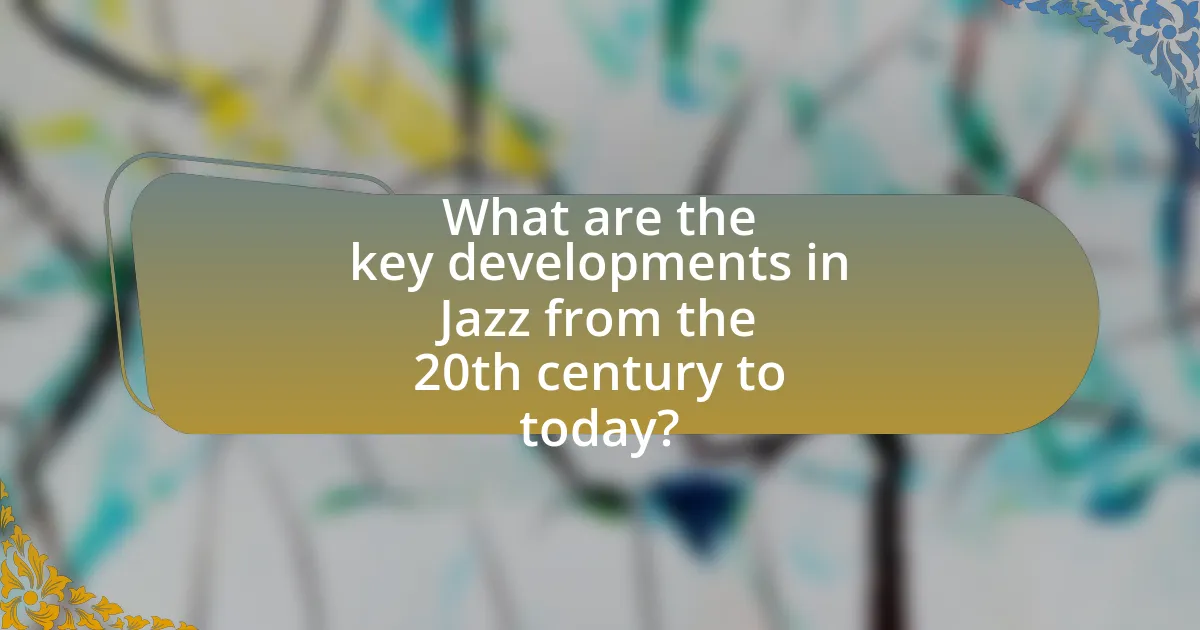
What are the key developments in Jazz from the 20th century to today?
Key developments in jazz from the 20th century to today include the emergence of various subgenres such as bebop, cool jazz, free jazz, and fusion. Bebop, developed in the 1940s, introduced complex harmonies and fast tempos, with artists like Charlie Parker and Dizzy Gillespie leading the movement. Cool jazz, which followed in the late 1940s and 1950s, emphasized a more relaxed style, exemplified by musicians like Miles Davis and Dave Brubeck. The 1960s saw the rise of free jazz, characterized by improvisation and avant-garde techniques, with figures like Ornette Coleman pushing boundaries. Fusion, which emerged in the late 1960s and 1970s, blended jazz with rock and funk elements, featuring artists like Herbie Hancock and Chick Corea. These developments reflect the genre’s adaptability and continuous evolution, influencing contemporary jazz and its integration with other musical styles.
How did the Jazz scene change during the 1950s and 1960s?
The Jazz scene transformed significantly during the 1950s and 1960s, marked by the emergence of new styles such as bebop, cool jazz, and free jazz. Bebop, pioneered by musicians like Charlie Parker and Dizzy Gillespie, shifted the focus from danceable rhythms to complex melodies and improvisation, emphasizing individual artistry. Cool jazz, represented by artists like Miles Davis and Dave Brubeck, introduced a more relaxed and sophisticated sound, often incorporating elements of classical music. The free jazz movement, led by figures such as Ornette Coleman, broke traditional structures, allowing for greater expression and experimentation. These changes reflected broader cultural shifts, including the civil rights movement, which influenced the themes and approaches within jazz music. The period also saw the rise of jazz as a form of serious art, gaining recognition in concert halls and academic settings, further solidifying its place in American culture.
What innovations did musicians introduce during this period?
Musicians during the evolution of jazz introduced several key innovations, including the use of improvisation, syncopation, and the incorporation of diverse musical influences. Improvisation became a hallmark of jazz, allowing musicians to express individuality and creativity in real-time performances. Syncopation, characterized by unexpected rhythms and accents, added complexity and excitement to the music. Additionally, musicians began blending elements from blues, ragtime, and African rhythms, which enriched the jazz genre and contributed to its development. These innovations were pivotal in transforming jazz from its New Orleans roots into a more complex and varied musical form.
How did the Civil Rights Movement influence Jazz music?
The Civil Rights Movement significantly influenced Jazz music by inspiring artists to incorporate themes of social justice and racial equality into their work. Musicians like John Coltrane and Max Roach used their platforms to address civil rights issues, with Coltrane’s “Alabama” directly responding to the 1963 Birmingham church bombing that killed four African American girls. This period saw Jazz evolve into a medium for protest and expression, reflecting the struggles and aspirations of the African American community. The movement’s emphasis on empowerment and identity led to the emergence of styles such as free jazz, which broke traditional boundaries and embraced improvisation as a form of personal and political expression.
What is Modern Fusion Jazz?
Modern Fusion Jazz is a genre that blends elements of jazz with various other musical styles, including rock, funk, and electronic music. This genre emerged in the late 20th century, characterized by its experimental approach and incorporation of diverse instruments and rhythms. Notable artists such as Miles Davis and Herbie Hancock played pivotal roles in its development, particularly through albums like “Bitches Brew” and “Head Hunters,” which showcased innovative techniques and cross-genre collaborations. The genre reflects the ongoing evolution of jazz, adapting to contemporary influences while maintaining its core improvisational essence.
How does Modern Fusion incorporate elements from other genres?
Modern Fusion incorporates elements from other genres by blending jazz with styles such as rock, funk, hip-hop, and world music. This genre fusion is characterized by the use of electric instruments, complex rhythms, and improvisational techniques that draw from these diverse musical traditions. For instance, artists like Herbie Hancock and Chick Corea have integrated funk grooves and electronic sounds into their compositions, demonstrating how Modern Fusion expands the boundaries of jazz by incorporating the rhythmic and harmonic elements of rock and funk. Additionally, the incorporation of world music influences can be seen in the works of musicians like John McLaughlin, who combines Indian classical music with jazz improvisation, further illustrating the genre’s adaptability and evolution.
Who are the prominent artists in the Modern Fusion Jazz scene?
Prominent artists in the Modern Fusion Jazz scene include Kamasi Washington, Snarky Puppy, and Esperanza Spalding. Kamasi Washington is known for his expansive compositions and innovative approach, exemplified in his album “The Epic,” which received critical acclaim and showcased a blend of jazz, classical, and hip-hop influences. Snarky Puppy, a collective led by bassist Michael League, has garnered multiple Grammy Awards for their genre-blending sound that incorporates elements of funk, rock, and world music. Esperanza Spalding, a Grammy-winning bassist and vocalist, is recognized for her unique fusion of jazz with elements of R&B and classical music, particularly in her album “Emily’s D+Evolution.” These artists exemplify the diverse and evolving nature of Modern Fusion Jazz.

What are the future trends in Jazz music?
Future trends in jazz music include increased fusion with electronic music, a rise in global influences, and a focus on social and political themes. The integration of technology, such as live looping and digital production, is reshaping how jazz is performed and recorded, allowing for innovative soundscapes. Additionally, artists are drawing inspiration from diverse cultural backgrounds, leading to a more eclectic sound that reflects a globalized world. The emphasis on social issues, particularly in the wake of movements like Black Lives Matter, is prompting musicians to use their art as a platform for activism, thus evolving the narrative within jazz. These trends are supported by the growing popularity of genre-blending artists and the increasing accessibility of music production tools, which encourage experimentation and collaboration across genres.
How is technology shaping the future of Jazz?
Technology is shaping the future of Jazz by enabling innovative music creation, distribution, and collaboration. Digital audio workstations (DAWs) allow musicians to compose and produce music with unprecedented ease, facilitating the blending of traditional Jazz elements with modern genres. Additionally, streaming platforms like Spotify and Apple Music provide wider access to Jazz, reaching diverse audiences and promoting new artists. The use of artificial intelligence in music composition is also emerging, with tools that can analyze existing Jazz styles and generate new compositions, thus expanding the genre’s boundaries. These advancements illustrate how technology not only preserves Jazz heritage but also propels its evolution into new forms.
What role do digital platforms play in promoting Jazz?
Digital platforms play a crucial role in promoting Jazz by providing artists with accessible channels to share their music and connect with audiences globally. These platforms, such as Spotify, YouTube, and social media, enable Jazz musicians to distribute their work without the need for traditional record labels, thus democratizing the music industry. For instance, Spotify reported that Jazz streams increased by 20% from 2019 to 2020, highlighting the genre’s growing popularity through digital means. Additionally, social media allows artists to engage directly with fans, fostering community and increasing visibility for live performances and new releases.
How are new artists using social media to reach audiences?
New artists are using social media platforms to reach audiences by leveraging targeted content, engaging directly with fans, and utilizing algorithms to enhance visibility. For instance, platforms like Instagram and TikTok allow artists to share snippets of their music, behind-the-scenes content, and personal stories, which fosters a sense of connection and community. According to a 2021 report by the International Federation of the Phonographic Industry, 70% of music consumers discover new artists through social media, highlighting its effectiveness in audience outreach. Additionally, artists can use analytics tools provided by these platforms to tailor their content based on audience preferences, further increasing engagement and reach.
What can listeners do to support the evolution of Jazz?
Listeners can support the evolution of Jazz by actively engaging with the genre through attendance at live performances, purchasing music, and sharing their experiences on social media. By attending concerts, listeners provide financial support to artists and venues, which is crucial for the sustainability of Jazz music. Purchasing albums and merchandise directly contributes to the artists’ income, allowing them to continue creating innovative works. Additionally, sharing experiences and promoting Jazz on social media platforms increases visibility and attracts new audiences, fostering a broader appreciation for the genre. This engagement not only sustains existing artists but also encourages new talent to emerge, ensuring the ongoing evolution of Jazz.
How can attending live performances contribute to the Jazz community?
Attending live performances significantly contributes to the Jazz community by fostering a vibrant culture of collaboration and innovation among musicians. Live events provide a platform for artists to showcase their talents, experiment with new styles, and engage with audiences, which enhances the overall musical experience. Furthermore, according to a study by the National Endowment for the Arts, live music events increase community engagement and support local economies, thereby strengthening the Jazz scene. This interaction not only cultivates a loyal fan base but also encourages the next generation of musicians to participate in the genre, ensuring its continued evolution and relevance.
What resources are available for learning more about Jazz music?
Books, online courses, documentaries, and music streaming services are valuable resources for learning more about Jazz music. Notable books include “The History of Jazz” by Ted Gioia, which provides a comprehensive overview of the genre’s development, and “Jazz: A History” by Ken Burns, which accompanies the acclaimed PBS documentary series. Online platforms like Coursera and MasterClass offer courses taught by renowned musicians, enhancing understanding through structured lessons. Documentaries such as “Jazz” by Ken Burns present historical context and influential figures in the genre. Additionally, music streaming services like Spotify and Apple Music feature curated Jazz playlists and artist discographies, allowing listeners to explore various styles and eras of Jazz music.
